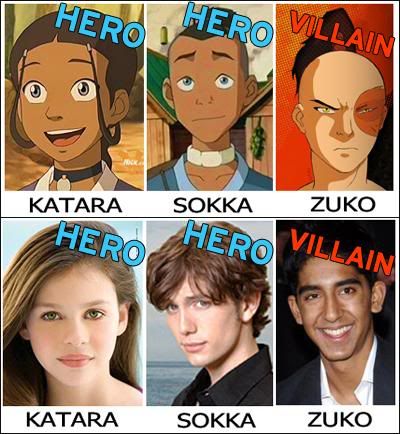By: Inoljt, http://mypolitikal.com/
Summer is in full swing, which means that Hollywood has come out with the usual set of summer blockbusters. This year’s summer movies – from Inception to Despicable Me – have generally been good quality, well-done things. Indeed, the film Inception may become one of the great classics of movie fame.
Then there was The Last Airbender, by M. Night Shyamalan – a movie which may earn the title as the worst movie this year. From its inception (pardon the pun) to its sorry release, Airbender has been dogged in the wake of controversial casting decisions. The graphic below neatly summarizes the controversy:
More below.
Shyamalan has also been criticized for yellowface – casting white actors to play Asian main characters, although the TV series Avatar, upon which the movie was based off of, puts itself in an East Asian setting. The evidence for the latter claim is fairly strong. Take, for instance, the following six battles: the Siege of Ba Sing Se, the Battle of Dien Bien Phu, the Battle of Han Tui, the Hu Xin Provinces Campaign, the Battle of Jinyang, and the Battle of Kapyong. Some are from Avatar and some constitute real-life events in Asian history.
It’s fairly difficult to tell which is which. As it turns out, the first, third, and fourth events are from Avatar; the rest are actual historical battles (congratulations if you recognized the second name, and even more congratulations if you recognized the last name).
The puzzle, then, is why Hollywood does things like this – why it, for instance, continues the practice of yellow-face more than half-a-century after blackface was rightfully ended.
Simple old-fashioned racism does not fully answer the question. Shyamalan himself is Indian, yet cast an Indian actor as the villain. Most people in entertainment are not racists in disguise, although their pool of friends may lack diversity (in this they are not much different from most people). The vast majority probably voted for President Barack Obama, for instance. Most probably view segregation or Japanese internment as tremendous wrongs in American history. Some even go all the way and marry interracially (often, ironically enough, with an Asian-American women), before casting a white actor to play an Asian lead.
The answer, rather, seems to involve economics and the faceless forces of the market. Take supply and demand. It would not be unreasonable to assume that the vast majority of Hollywood’s available labor pool is white. Becoming a Hollywood superstar is something that appeals to a very specific demographic, and that demographic is probably paler than America itself. There are, moreover, not many Asian-Americans in entertainment. Choosing the white actor to play a non-white role may simply be the easier path.
Hollywood’s writers and producers also have families to feed and ambitions to make it big, ambitions to which some principles can be sacrificed. Shyamalan and others of his industry want to make productions that sell; that constitutes the purpose of their job. And they think that a show without a white male lead would be less popular – which is often true. So they set white male leads because they think only those types of shows will sell. They make what they think the audience will accept.
Ironically, this probably causes the audience to become even less accepting of non-white, non-male leads since they’re so used to the traditional version. It’s a self-perpetuating cycle.
Yet for all this, practices like yellow-face do not seem entirely justified from a purely financial perspective. Shaylaman’s movie, after all, turned out into a disaster despite his best efforts to appeal to white America. Americans have proved willing to watch movies with black male leads, despite early fears. Movies such as Despicable Me and District 9 have cast main characters who speak in accented English; those movies also did well.
Finally there is the international market to factor in. Rich Asian countries such as Japan, South Korea, Taiwan constitute an increasingly important audience. Then there is the growing market in China. China allows only twenty Hollywood movies a year; because of Shyalaman’s controversial casting, The Last Airbender will almost certainly not make the cut.
If Hollywood and the American entertainment industry wake up to these facts, they might realize that a change in practices such as yellow-face would probably gain them sales – and besides, it’d also be the right thing to do.

6 comments